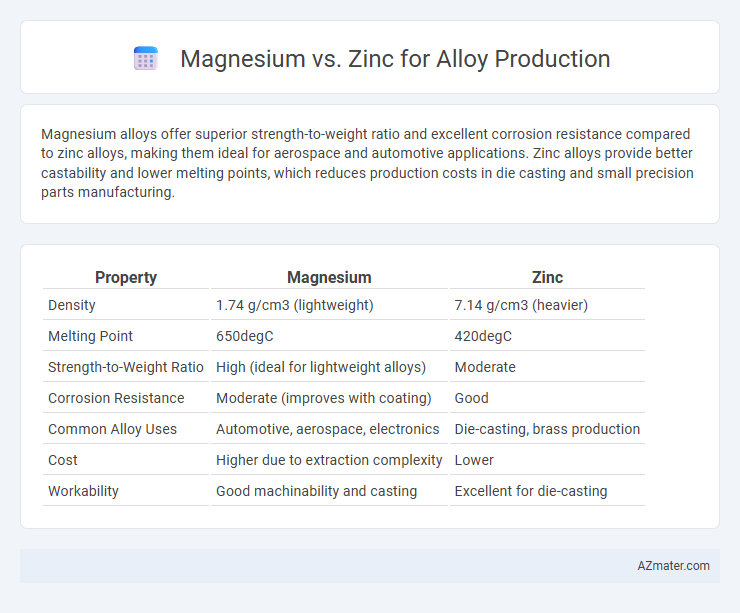Magnesium alloys offer superior strength-to-weight ratio and excellent corrosion resistance compared to zinc alloys, making them ideal for aerospace and automotive applications. Zinc alloys provide better castability and lower melting points, which reduces production costs in die casting and small precision parts manufacturing.
Table of Comparison
| Property | Magnesium | Zinc |
|---|---|---|
| Density | 1.74 g/cm3 (lightweight) | 7.14 g/cm3 (heavier) |
| Melting Point | 650degC | 420degC |
| Strength-to-Weight Ratio | High (ideal for lightweight alloys) | Moderate |
| Corrosion Resistance | Moderate (improves with coating) | Good |
| Common Alloy Uses | Automotive, aerospace, electronics | Die-casting, brass production |
| Cost | Higher due to extraction complexity | Lower |
| Workability | Good machinability and casting | Excellent for die-casting |
Introduction to Alloy Production
Magnesium and zinc are critical elements in alloy production due to their distinct physical and chemical properties that enhance metal performance. Magnesium alloys offer lightweight solutions with excellent strength-to-weight ratios, making them ideal for aerospace and automotive industries. Zinc alloys provide superior corrosion resistance and castability, commonly used in die casting and surface coatings to improve durability.
Key Properties of Magnesium and Zinc
Magnesium offers low density, excellent strength-to-weight ratio, and superior corrosion resistance, making it ideal for lightweight alloy production in aerospace and automotive industries. Zinc contributes high ductility, excellent wear resistance, and effective galvanic protection, enhancing alloy durability and formability. Both elements provide distinct benefits, with magnesium emphasizing weight reduction and zinc focusing on mechanical strength and corrosion inhibition.
Historical Use of Magnesium and Zinc in Alloys
Magnesium and zinc have both played crucial roles in alloy production, with magnesium historically favored for its lightweight properties in aerospace and automotive industries since the early 20th century. Zinc has been extensively used in brass alloys, dating back thousands of years, prized for its corrosion resistance and machinability. The evolving use of magnesium-zinc alloys illustrates ongoing efforts to optimize strength-to-weight ratios in modern engineering applications.
Magnesium Alloys: Strengths and Limitations
Magnesium alloys exhibit exceptional strength-to-weight ratios, making them ideal for aerospace and automotive applications where weight reduction is critical. Their excellent machinability and damping capacity enhance performance in structural components, though their susceptibility to corrosion and lower creep resistance compared to zinc alloys limits their use in high-temperature environments. Advances in coating technologies and alloying elements aim to mitigate these limitations, expanding magnesium alloys' industrial viability.
Zinc Alloys: Strengths and Limitations
Zinc alloys offer excellent corrosion resistance, high ductility, and ease of casting, making them ideal for complex shapes and precision components in alloy production. Their relatively low melting point of around 420degC allows energy-efficient manufacturing processes, though their strength is generally lower compared to magnesium alloys. Zinc alloys are prone to creep under high stress and elevated temperatures, limiting their use in high-strength or high-temperature applications.
Cost Comparison: Magnesium vs Zinc
Magnesium alloys typically cost more than zinc alloys due to the higher raw material price and processing expenses associated with magnesium. Zinc offers a more economical choice for alloy production because of its lower melting point, resulting in reduced energy consumption and faster manufacturing cycles. Despite magnesium's higher cost, its superior strength-to-weight ratio often justifies the investment in applications requiring lightweight materials.
Corrosion Resistance in Magnesium and Zinc Alloys
Magnesium alloys exhibit superior corrosion resistance compared to zinc alloys due to the formation of a stable oxide layer that protects the metal surface in various environments. Zinc alloys, while offering moderate corrosion resistance, are more susceptible to galvanic corrosion when in contact with dissimilar metals. Optimizing alloy composition by balancing magnesium's lightweight properties with zinc's strength can enhance overall corrosion performance in industrial applications.
Industrial Applications: Magnesium vs Zinc Alloys
Magnesium alloys offer superior strength-to-weight ratios, making them ideal for aerospace and automotive industries where weight reduction is crucial for fuel efficiency and performance. Zinc alloys provide excellent corrosion resistance and wear properties, widely used in die-casting for electrical components and hardware manufacturing. The selection between magnesium and zinc alloys depends on specific industrial requirements such as mechanical strength, thermal conductivity, and environmental resistance.
Environmental and Safety Considerations
Magnesium alloys offer lightweight properties but pose higher fire risks due to their flammability and difficulty in extinguishing magnesium fires, requiring special handling and storage protocols to ensure safety. Zinc alloys are less flammable and produce fewer hazardous emissions during melting and casting, making them more environmentally stable and safer for manufacturing environments. Recycling zinc is also more energy-efficient compared to magnesium, reducing the overall environmental footprint of alloy production.
Choosing the Right Metal for Alloy Production
Magnesium offers exceptional strength-to-weight ratio and excellent corrosion resistance, making it ideal for lightweight alloy production in automotive and aerospace industries. Zinc provides superior casting properties and cost-effectiveness, widely used in die-casting alloys for complex shapes and high dimensional accuracy. Selecting the right metal depends on the desired mechanical properties, weight requirements, and application environment of the final alloy product.

Infographic: Magnesium vs Zinc for Alloy Production
 azmater.com
azmater.com